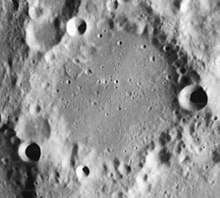La Caille (crater)
La Caille is a lunar impact crater located in the rugged south-central highlands of the Moon. It was named after the French astronomer Nicolas-Louis de Lacaille.[1] It is located to the northeast of the crater Purbach. Nearly attached to the southeast rim are the remains of Blanchinus, and the two are separated by a rugged stretch of terrain. To the northeast is Delaunay, a formation split in half by a ridge.
 Lunar Orbiter 4 image | |
| Coordinates | 23.8°S 1.1°E |
|---|---|
| Diameter | 68 km |
| Depth | 2.8 km |
| Colongitude | 358° at sunrise |
| Eponym | Nicolas-Louis de Lacaille |
The floor of La Caille has been flooded in the past by lava, and the surface is relatively smooth and flat with no central rise. Only a few tiny craterlets along the north and northwest edges disrupt the surface. Ray material lies across the central and southern parts of the floor, most likely from Tycho to the southwest.
The rim of this crater is heavily worn and battered, with notches around the interior edge and craters across the top and along the exterior. The most notable of these is La Caille B which lies across the eastern rim.
For a few hours before the first quarter, the crater's rim contributes to the Lunar X visual phenomenon.
Satellite craters

By convention these features are identified on lunar maps by placing the letter on the side of the crater midpoint that is closest to La Caille.
| la Caille | Latitude | Longitude | Diameter |
|---|---|---|---|
| A | 22.8° S | 0.4° E | 8 km |
| B | 20.9° S | 1.4° E | 7 km |
| C | 21.2° S | 1.4° E | 15 km |
| D | 23.6° S | 2.2° E | 12 km |
| E | 23.5° S | 2.8° E | 27 km |
| F | 23.6° S | 3.4° E | 8 km |
| G | 20.5° S | 2.0° E | 11 km |
| H | 24.7° S | 0.8° E | 6 km |
| J | 22.5° S | 0.9° E | 5 km |
| K | 21.0° S | 0.6° E | 30 km |
| L | 24.6° S | 1.4° E | 5 km |
| M | 22.3° S | 1.6° E | 15 km |
| N | 21.9° S | 1.3° E | 10 km |
| P | 22.5° S | 0.0° E | 25 km |
References
- "La Caille (crater)". Gazetteer of Planetary Nomenclature. USGS Astrogeology Research Program.
- Andersson, L. E.; Whitaker, E. A. (1982). NASA Catalogue of Lunar Nomenclature. NASA RP-1097.CS1 maint: ref=harv (link)
- Bussey, B.; Spudis, P. (2004). The Clementine Atlas of the Moon. New York: Cambridge University Press. ISBN 978-0-521-81528-4.CS1 maint: ref=harv (link)
- Cocks, Elijah E.; Cocks, Josiah C. (1995). Who's Who on the Moon: A Biographical Dictionary of Lunar Nomenclature. Tudor Publishers. ISBN 978-0-936389-27-1.CS1 maint: ref=harv (link)
- McDowell, Jonathan (July 15, 2007). "Lunar Nomenclature". Jonathan's Space Report. Retrieved 2007-10-24.CS1 maint: ref=harv (link)
- Menzel, D. H.; Minnaert, M.; Levin, B.; Dollfus, A.; Bell, B. (1971). "Report on Lunar Nomenclature by the Working Group of Commission 17 of the IAU". Space Science Reviews. 12 (2): 136–186. Bibcode:1971SSRv...12..136M. doi:10.1007/BF00171763.CS1 maint: ref=harv (link)
- Moore, Patrick (2001). On the Moon. Sterling Publishing Co. ISBN 978-0-304-35469-6.CS1 maint: ref=harv (link)
- Price, Fred W. (1988). The Moon Observer's Handbook. Cambridge University Press. ISBN 978-0-521-33500-3.CS1 maint: ref=harv (link)
- Rükl, Antonín (1990). Atlas of the Moon. Kalmbach Books. ISBN 978-0-913135-17-4.CS1 maint: ref=harv (link)
- Webb, Rev. T. W. (1962). Celestial Objects for Common Telescopes (6th revised ed.). Dover. ISBN 978-0-486-20917-3.CS1 maint: ref=harv (link)
- Whitaker, Ewen A. (1999). Mapping and Naming the Moon. Cambridge University Press. ISBN 978-0-521-62248-6.CS1 maint: ref=harv (link)
- Wlasuk, Peter T. (2000). Observing the Moon. Springer. ISBN 978-1-85233-193-1.CS1 maint: ref=harv (link)
External links
| Wikimedia Commons has media related to La Caille (crater). |
- La Caille at The Moon Wiki
- Nemiroff, Robert; Bonnell, Jerry (December 10, 2016). "The Lunar X". Astronomy Photo of the Day (APOD).